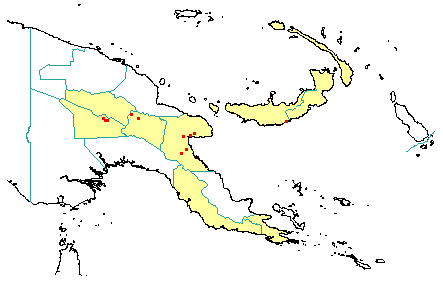
in PNGplants database
PNGTreesKey – Turpinia pentandra (Schltr.) B.L.Linden |
Barry Conn (NSW) & Kipiro Damas (LAE).
Guide to trees of Papua New Guinea
Copyright held by the authors, National Herbarium of New South Wales, and Papua New Guinea National Herbarium
Nova Guinea, New Series Vol. 10: 212 (1959)
Other Literature: W.R. Barker, Handbooks of the Flora of Papua New Guinea 259-261 (1981) Fig. 60.
Family: Staphyleaceae
Dicotyledon
Timber Group: Non-timber species
Field Characters: Large canopy tree (20-30 m high, less frequently to 40 m high); Bole cylindrical (to slightly fluted, 35-50 cm diam.); straight (bole c. 10 m long); buttresses buttresses absent or usually buttresses present; spines spines absent; aerial roots aerial roots absent; stilt roots stilt roots absent; Bark grey or brown, slightly rough, slightly pustular or slightly fissured, lenticels elongated vertically; Subrhytidome (under-bark) yellow or orange; less than 25 mm thick, 14.0-16.0; bark blaze consisting of one layer; strongly aromatic; faintly onion-like; outer blaze orange, yellow, or greyish white, speckled, granular with splinters or slightly corky; inner blaze yellow, orange, or greyish white, speckled, granular with splinters or slightly corky; bark exudate (sap) present, colourless, flowing, colour not changing on exposure to air, sticky; terminal buds not enclosed by leaves.
Indumentum: Complex hairs absent; stinging hairs absent; mature twig indumentum (hairs) present or absent, hairs sparse.
Leaves: Leaves spaced along branches, opposite (in pairs, opposite one another on the branchlet), compound (a leaf made up from two or more leaflets); petiole present, not winged, attached to base of leaf blade, not swollen; leaves pinnate (unbranched with more than three leaflets); petiolule not swollen; rachis present, absent, absent; leaves with a terminal leaflet (the number of leaflets odd - imparipinnate), broadest at or near middle or broadest below middle, (5.0-) 8.0-18.0 (-25.0) cm, (2.0-) 3.0-10.0 (-15.0) cm, leaflets opposite, symmetric, terminal developing leaflet buds straight; venation pinnate, secondary veins open, prominent, intramarginal veins absent; leaves lower surface pale green, upper surface dark green, indumentum (hairs) usually absent or rarely present, indumentum (hairs) sparse; absent; domatia absent; stipules present, free, laterally placed, not encircling the twig, triangular leafy, not fringed, small (4-9 mm long), not persistent.
Flowers: Inflorescence axillary, flowers on a branched axis, cones absent; flowers bisexual, stalked, flowers with many planes of symmetry, 1.2-3.0 mm long, diameter small (up to10 mm diam.) (1.5-2.5 mm diam.); perianth present, with distinct sepals and petals whorls, inner perianth white, pale red, or cream-coloured; 5, free; stamens 5, present, free of each other, free of the perianth; ovary superior, carpels separate (when more than one) (upper one-third soon free) or joined (when more than one), locules 3; styles free (with fused stigmas), 3.
Fruits: Infrutescence arranged on branched axis, fruit 20.0-28.0 mm long, 20.0 (c.) mm diam., yellow or green, not spiny, slightly fleshy, simple, indehiscent, berry; seeds or more 3-12, to about 5 mm long, not winged, slightly irregular or broad (as wide as long) (slightly angular), seed 1-10 mm diam.
Distribution: Morobe, Western Highlands, Eastern Highlands, Southern Highlands, Central, Milne Bay, New Britain & New Ireland.
 | Botanical records in PNGplants database |